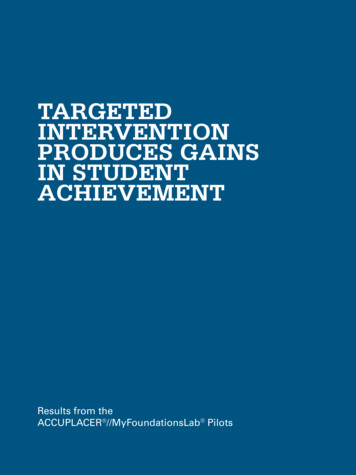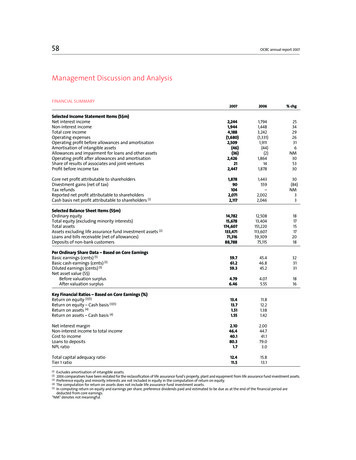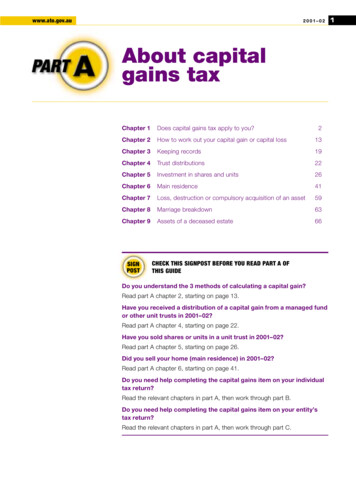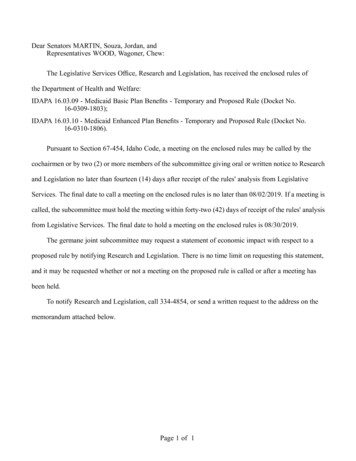
Transcription
TargetedInterventionProduces Gainsin studentachievementResults from theACCUPLACER //MyFoundationsLab Pilots
Results from the ACCUPLACER//MyFoundationsLab PilotsACCUPLACER //MyFoundationsLab is a comprehensive online diagnostic and intervention systemthat assesses and builds students’ academic skills in reading, writing, and mathematics. It offers aunique combination of computer-adaptive assessments that analyze a student’s academic strengthsand weaknesses, then provides customized online intervention. Based on their initial ACCUPLACERdiagnostic scores, students are given a personalized learning path through MyFoundationsLab toimprove their skills and master core concepts. Faculty can use ACCUPLACER and MyFoundationsLab tocomplement their curriculum while preparing students for college and success.www.accumfl.comACCUPLACER is a computer-adaptive diagnostic, online intervention and placement testing systemthat assesses student academic skills in reading, writing, and mathematics in an immediate and accurateway. Teachers and counselors can use the results of these assessments to determine students’ strengthsand weaknesses to provide early academic intervention. Administering more than eight million tests peryear, the ACCUPLACER system is used by more than 1,300 secondary and postsecondary institutions toplace students in the appropriate courses where they can confidently meet classroom requirements.For further information, visit www.collegeboard.org/accuplacer.Contact us at: info@accuplacer.org or 866-607-52233
Background on PilotsThis past year, the College Board’s ACCUPLACER program conducted pilots with high schools, charterschools, community colleges and summer bridge programs. The purpose of the pilots was to validatethat ACCUPLACER diagnostic tests, paired with an integrated online intervention curriculum throughMyFoundationsLab (MFL), can address students’ academic gaps and directly impact their readiness forpostsecondary success and college-level work.The cohort of students who participated in these pilots included entering college freshmen, high school seniorsand eighth-graders. All students took ACCUPLACER diagnostic tests as pre-assessment tools to determinethe skill areas in which they were proficient and the skill areas needing improvement. Some pilot institutionsused the ACCUPLACER placement tests as pre- and post-assessment tools to measure improvement ineither students’ scores or their placement levels. Others used the ACCUPLACER diagnostic tests as postassessment tools to determine improvement in either the students’ scores or their proficiency levels.Instructional ModelsEach pilot site had the autonomy to choose one of the following instructional models during theimplementation of the ACCUPLACER//MyFoundationsLab online intervention curriculum.Independent Study (IS): This instructional model allows students to work completely on their own in theACCUPLACER//MyFoundationsLab online intervention curriculum. There is no provision for dedicated classtime or access to hardware; students must provide their own computer and must manage their own learningwithout access to a teacher/instructor.Independent Study with Guidance (IS Guidance): This instructional model allows students to work ontheir own in the ACCUPLACER//MyFoundationsLab online intervention curriculum while also receiving somemonitoring and guidance from a teacher/instructor. There is no provision for dedicated class time or access tohardware; students must provide their own computer and manage their own learning with minimal support.Lab: This instructional model allows students to work on their own on the ACCUPLACER//MyFoundationsLabonline intervention curriculum while receiving ongoing guidance and monitoring from a teacher/instructor. Accessto technology is provided on a regular basis as part of a scheduled class or a required lab outside of class.Blended Learning: This instructional model allows the teacher/instructor to manage the pace of theintervention program and assignment of MyFoundationsLab content so that it is integrated with ongoinginstruction in a course. Access to technology can be provided in class or be required outside of class. Theteacher/instructor provides ongoing guidance and monitoring of student achievement.Measures of SuccessTo measure improvement in student achievement as a result of the intervention, each pilot site used metricsthat were aligned to the site’s goals and the needs of its students. The pilot sites compared student resultsfrom ACCUPLACER pre-assessment tests to student results from ACCUPLACER post-assessment tests thatwere administered after the implementation of the MyFoundationsLab online intervention curriculum.4
Results from the ACCUPLACER//MyFoundationsLab PilotsImprovement was measured through:Improvement in Scores: Pilot sites were able to report average score gains for their cohort of students bycomparing students’ scores from pre- to post-assessment. For sites that administered Diagnostics as both preand post-tests, they were able to compare score gains in each of the five domains on each diagnostic test.Improvement in Placement Levels: Pilot sites were able to identify the percentage of studentswho improved their course placement and the number of courses bypassed by comparing students’placement levels from pre- to post-assessment. Pilots used the ACCUPLACER placement test as the preand post-assessment measure.Improvement in Proficiency Levels: Pilot sites were able to report improvement in performance for theircohort of students by comparing students’ proficiency gains from pre- to post-assessment. Pilots used theACCUPLACER diagnostic test as a pre- and post-assessment tool to determine the percentage of studentswho advance to a new proficiency level — Needs Improvement to Limited Proficiency to Proficient.5
Intervention MattersResults collected from 10 pilot studies led to the following conclusions:àà Targeted intervention through ACCUPLACER//MyFoundationsLab produces improvement in studentachievement regardless of the duration of the intervention, the students’ grade level or the model ofinstruction.àà Online intervention curriculum connected to the results of ACCUPLACER Diagnostics produces strongergains in student achievement than less targeted instruction.àà More instructor involvement in the intervention process (monitoring progress, setting expectations andproviding structure) produces stronger gains in student achievement than Independent Study.àà Personalized intervention through ACCUPLACER//MyFoundationsLab leads to increased persistence andenrollment rates.Name of Pilot SiteStudent CohortPurpose of ParticipationPanola Charter School8th-gradersPreparation for dual enrollment programMississippi Institutions of Higher Learning(MS IHL)9th-gradersTargeted interventionCerritos College9th-gradersTargeted interventionEast Los Angeles College9th-gradersTargeted interventionMontgomery County Public Schools(MCPS)12th-gradersEarly intervention for college readinessJefferson Community College12th-gradersEarly intervention foroccupation-track programsWashoe County School District (WCSD)12th-gradersTargeted intervention11th- and 12th-gradersTargeted intervention12th-gradersEarly intervention for college readinessCollege students in GED anddevelopmental coursesTargeted interventionDelaware Department of Education(DDOE)Thomas Jefferson High School (TJHS)Middlesex Community College6
Results from the ACCUPLACER//MyFoundationsLab PilotsFollowing the ACCUPLACER//MyFoundationsLab online intervention, 32% to as many as 92% of the studentsimproved their proficiency level, course placement level or scores across all subjects in the ACCUPLACER postassessment tests. The subjects include: Reading Comprehension (RC), Sentence Skills (SS), Arithmetic (AR), ElementaryAlgebra (EA) and College-Level Math (CLM).% of Participants with ntin ProficiencyLevelImprovementin CoursePlacementLevelImprovementinScoresPilot NameStudentCohortTest Usedto MeasureProgressInterventionUsedModel 8th-gradersDiagnosticACCU//MFLIS Guidance1253%37%32%*11%N/ADDOE11th- and12th-gradersDiagnosticACCU//MFLIS Blended1091%90%88%79%–East LAFreshmenPlacementACCU//MFLIS Guidance2N/AN/A**36%**36%N/AEast LAFreshmenPlacementGeneral MFLIS Guidance2N/AN/A0%0%N/AMCPS MCPS itosCollegeFreshmenDiagnosticACCU//MFLIS entACCU//MFLIS ACCU//MFLIS Guidance3676%66%–52%–Jefferson CCCohort %Jefferson CCCohort 212th-gradersDiagnosticACCU//MFLIS Guidance4455%50%49%N/A58%Jefferson CCCohort N/A60%MS IHLFreshmenPlacementACCU//MFLLab940%64%N/A92%N/A* EA (Elementary Algebra) increased through independent study with MFL even though this cohort had not taken a high school Algebra course.** Improvement in course placement was based on both AR (Arithmetic) and EA (Elementary Algebra) test scores.7
“Of the students who finished the pilot,100% of them showed improvementon the ACCUPLACER diagnostic test.ACCUPLACER//MyFoundationsLab isdefinitely something to consider if you aredealing with college readiness issues inEnglish, reading or math.”— Bryan Reece, Dean of Academic Success andInstitutional Effectiveness,Cerritos College, Norwalk, Calif.Targeted Intervention Leads to ImprovementPanola Charter School in Carthage, Texas, offered ACCUPLACER//MyFoundationsLab to a group of eighthgraders to help them qualify for dual enrollment college courses. The instructional model adopted wasIndependent Study with Guidance. After a 12-week treatment with the ACCUPLACER//MyFoundationsLab,students increased their proficiency level in the post-assessment tests.àà 53% of the students moved into the proficient level in Reading Comprehension.àà 11% of the students moved into the proficient level in Elementary Algebra.àà 37% of the students moved into the proficient level in Sentence Skills.àà 32% of the students moved into the proficient level in Arithmetic.Mississippi Institutions of Higher Learning in Jackson, Miss., implemented ACCUPLACER//MyFoundationsLabas part of its Summer Developmental Program. Entering college students received individualized instructionthrough lab time. After nine weeks of intervention, students showed score gains in their post-assessmenttests in reading, writing and mathematics.àà 40% of the students showed improvement in scores in Reading Comprehension.àà 64% of the students showed improvement in scores in Sentence Skills.àà 92% of the students showed improvement in scores in Elementary Algebra, with a statisticalsignificance of p 0.05.Cerritos College, a two-year institution in Norwalk, Calif., created a special “prep” course usingACCUPLACER//MyFoundationsLab. The instructional model adopted was Independent Study with Guidance.Entering college students took the ACCUPLACER diagnostic tests and received six weeks of targetedintervention (the standard semester course is 15 weeks). After the intervention, the students’ performance inthe post-assessment test indicated a jump in course placement levels.àà 54% of the students increased their placement scores in Reading Comprehension; 28% improved theirReading Comprehension placement level by one or more courses.àà 62% of the students increased their placement scores in Sentence Skills; 40% improved their Englishcourse placement level by one or more courses.àà 46% of the students improved their math course placement level by one or more courses.8
Results from the ACCUPLACER//MyFoundationsLab PilotsWashoe County School District in Reno, Nev., offered ACCUPLACER//MyFoundationsLab to a group of12th-graders to help increase their placement into college courses. The district tested all 12th-graders withplacement tests, then offered access to ACCUPLACER//MyFoundationsLab for students wishing to improvetheir course placement with an Independent Study with Guidance model for 36 weeks.àà Upon post-testing, 53% of students increased their course placement by one or two levels, savingthemselves both time and money.àà Of students increasing their course placement, 78% increased their placement by two course levels.The Delaware Department of Education used ACCUPLACER//MyFoundationsLab in five high schools aroundthe state to provide a college readiness instruction for 11th- and 12th-grade students in both Math and English.Students were pre-tested with Diagnostics, then worked on their individual learning paths for 10 weeks underboth Independent Study and Blended Learning models, then post-tested with ACCUPLACER Diagnostics.Students demonstrated impressive gains in scores.àà 88% of students gained in one or more areas in Arithmetic.àà 79% of students gained in one or more areas in Elementary Algebra.àà 91% of students gained in one or more areas in Reading Comprehension.àà 90% of students gained in one or more areas in Sentence Skills.Thomas Jefferson High School in Denver, Colo., implemented ACCUPLACER//MyFoundationsLab as part oftheir college readiness program with a group of 12th-graders. Students were pre-tested with placement teststo determine initial course placements, then worked on their assigned learning paths for 36 weeks. At theconclusion of the year, students who were post-tested with ACCUPLACER placement tests demonstratedimpressive gains in course placement.àà 59% of students gained course levels based on Reading Comprehension test results.àà 24% of students gained course levels based on Sentence Skills test results.àà 34% of students gained course levels based on Elementary Algebra test results.“The ACCUPLACER//MyFoundationsLab product actually helped our students jump upone or two levels in the post-assessment. Of the 58 students that completed the course,52% increased their placement level by one or more courses.”— Graciela Vasquez, Director of Adult Education,Cerritos College, Norwalk, Calif.9
10
Results from the ACCUPLACER//MyFoundationsLab PilotsDiagnostics Plus Online Intervention Produces Stronger ResultsEast LA Pilot — Average ScoreGains Pre-Test to 16.7%420Elementary AlgebraArithmeticEast Los Angeles College in Los Angeles, Calif., tested agroup of entering college freshmen as part of their fiveweek STEM Summer Bridge Program. The instructionalmodel adopted was Independent Study with Guidance.During the two-week intervention period devoted tomathematics, one group of students was treated usingan integrated ACCUPLACER//MyFoundationsLab onlinecurriculum, while another group of students was treatedusing another online learning tool. Students who usedACCUPLACER//MyFoundationsLab moved up in courseplacement levels, given their improvement on botharithmetic and Elementary Algebra test scores.àà 38% of the students who were treated with ACCUPLACER//MyFoundationsLab moved up one course level.àà 1 5% of the students who were treated with ACCUPLACER//MyFoundationsLab moved up two or morecourse levels.Students who were treated with another intervention tool showed some improvement in scores, but no increase incourse level placement.80%70%60%50%40%30%20%10%0%Montgomery County Public Schools% of Student undationsLabOtherMontgomery County Public Schools in Rockville, Md.,began a partnership with Montgomery College toincrease the number of graduates who were consideredcollege ready. They treated one group of high schoolseniors with targeted instruction through ACCUPLACER//MyFoundationsLab, and another group of high schoolseniors using a different intervention program. Theinstructional model adopted was Independent Study withGuidance. After the 44-week intervention period, studentswho were treated with ACCUPLACER//MyFoundationsLabindicated considerable improvement in courseplacement levels in all subjects.àà 64% of the students improved in Reading Comprehension.àà 71% of the students improved in Sentence Skills.àà 67% of the students improved in Algebra.àà 68% of the students improved in College-Level Math. lthough indicating some improvement, the students who used the online intervention tool that was not linked toAdiagnostic results performed half as well as the group using ACCUPLACER//MyFoundationsLab.”College readiness is a huge issue right now — one that we as community collegeadministrators, faculty and staff have to grapple with. ACCUPLACER//MyFoundationsLabhelps with student completion.”— Beverly Walker-Griffea, Senior Vice President for Student Services,Montgomery College, Rockville, Md.11
Independent Study with Guidance:Highly Effective Instructional ModelJefferson Community College in Watertown, N.Y., partnered with its local Board of CooperativeEducational Services to provide an intervention for students in vocational programs in order to reducethe need for developmental education when they matriculated in college. Three different cohorts ofstudents were chosen to participate in a 44-week ACCUPLACER//MyFoundationsLab online interventioncurriculum. Each cohort followed a different instructional model during the intervention: independent study,independent study with minimal instruction, and independent study with consistent guided instructionthrough a lab class.Although a significant percentage of students in all programs had increased their ACCUPLACERdiagnostic scores from pre-testing to post-testing, the highest percentage of score gains was achievedby the student cohort that used MyFoundationsLab as part of a structured class in addition to theirindependent study. From the student cohort that adopted a blended model of instruction (independentstudy plus guided instruction):àà 64% of the students achieved higher scores in Reading Comprehension.àà 68% of the students achieved higher scores in Sentence Skills.àà 68% of the students achieved higher scores in Arithmetic.àà 60% of the students achieved higher scores in College-Level Math.Jefferson Community College% of Students with Increased Scores80%70%60%50%40%30%20%10%0%12Jefferson CC Cohort 1 — ISJefferson CC Cohort 2 — IS Minimal GuidanceJefferson CC Cohort 3 — IS Guidance Through Lab eticCollege-LevelMath
Results from the ACCUPLACER//MyFoundationsLab PilotsACCUPLACER //MyFoundationsLab Leads toAcademic PersistenceMiddlesex Community College in Lowell, Mass., recently redesigned its developmental math curriculumto strengthen students’ academic skills. The redesigned curriculum model — called Accelerated LearningProgram (ALP) — incorporated intervention through ACCUPLACER//MyFoundationsLab. Middlesex decidedto adopt the ALP model for reading and writing courses that incorporated the use of MyFoundationsLab.Students who were enrolled in GED preparation courses and three levels of developmental courses forcollege reading, English fundamentals and basic writing took an ACCUPLACER diagnostic test in ReadingComprehension and Sentence Skills. Based on their performance, they were assigned an individualizedlearning path through MyFoundationsLab.During the 15 weeks of intervention, students engaged in independent study and had consistent guidedinstruction and access to MyFoundationsLab through lab time. Faculty and professional tutorsmonitored the students’ progress throughout the semester. At the completion of the intervention period,students who participated in the redesigned ALP courses had higher course completion rates thanstudents who were enrolled in a traditional course.àà 72% of the students completed the ALP course in writing with a C- or better; only 63% of thestudents did so in a traditional writing course.àà 71% of the students completed the ALP course in reading with a C- or better; only 53% of thestudents did so in a traditional reading course.àà Students who participated in the Accelerated Learning Program (81%) were more likely to persistand enroll for the following semester than students who participated in the traditional course (72%).Middlesex Community College% of Students Completing Course with a C or Better80%70%60%50%40%30%20%10%0AcceleratedLearning Programwith ACCUPLACER//MyFoundationsLabTraditional Course16.7%WritingReading“There seems to be a shift in [the] students’ view about the dreaded application problems(word problems). In the last few entries of their journals, students write that [because ofACCUPLACER//MyFoundationsLab] they have more confidence in their ability to formulate,generalize and solve problems mathematically.”— Anne Siswanto, Professor of Mathematics, East Los Angeles College, Los Angeles, Calif.13
“ACCUPLACER//MyFoundationsLab is a great tool and arsenal of resources that should beemployed when we are attempting to address the remediation issues within the schoolsystems across the nation.”— Genevieve Floyd, Supervisor for Career and Postsecondary Partnerships,Montgomery County Public Schools, Rockville, Md.
About the College BoardThe College Board is a mission-driven not-for-profit organization that connects students to college success andopportunity. Founded in 1900, the College Board was created to expand access to higher education. Today, themembership association is made up of over 6,000 of the world’s leading educational institutions and is dedicated topromoting excellence and equity in education. Each year, the College Board helps more than seven million studentsprepare for a successful transition to college through programs and services in college readiness and college success— including the SAT and the Advanced Placement Program . The organization also serves the education communitythrough research and advocacy on behalf of students, educators, and schools.For further information, visit www.collegeboard.org. 2014 The College Board. College Board, ACCUPLACER, Advanced Placement Program, SAT, and the acorn logo are registered trademarks of the College Board. Allother products and services may be trademarks of their respective owners. Visit the College Board on the Web: www.collegeboard.org.Copyright 2014 Pearson Education, Inc. or its affiliate(s). All rights reserved.13b-8589
12th-graders Early intervention for college readiness Jefferson Community College 12th-graders Early intervention for occupation-track programs Washoe County School District (WCSD) 12th-graders Targeted intervention . 12th-graders to help increase their placement into college courses. The district tested all 12th-graders with










